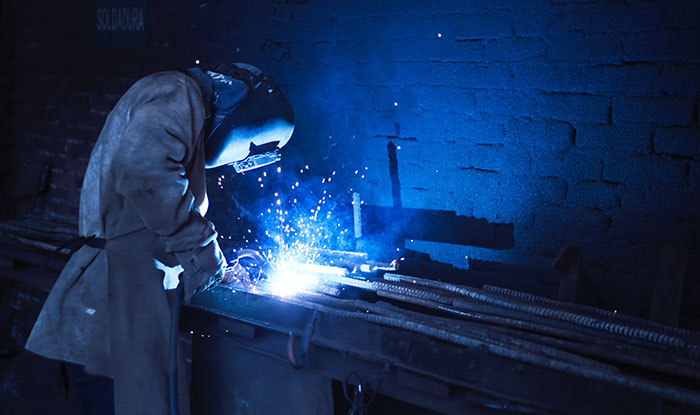Composite Toe vs. Steel Toe Work Boots: Which is Right for Your Industry?
Myths run rampant when deciding which type of safety shoe to wear. It has even gotten to the point where “MythBusters” dedicated an entire episode to combatting misinformation about steel-toe shoes. That’s a big problem since one of the essential safety shoe decisions you will make is whether to use steel toe or composite toe work boots.
Here are the differences between the two types of safety shoes and the correction of common myths circling the industry.
What’s the difference between composite toe and steel toe caps?
When it comes down to it, the right footwear can help your employees avoid most hazards, while the wrong footwear can cause more injuries. You must know the difference between your options to ensure your team is equipped with the right safety shoes.
Here’s what you need to know about the differences between steel toe and composite toe to make the right decision.
Materials
Composite toe safety shoes:
- Kevlar
- Carbon fiber
- Fiberglass
Steel toe safety shoes:
- Made from thin layers of steel
- May be reinforced with carbon fibers
Steel toe caps are heavier and more durable but conduct both cold and heat depending on weather conditions. On the other hand, composite toe caps are lighter, offer good protection, lose durability following accidents, are considered more comfortable, and do not conduct any cold or heat.
5 Composite vs. Steel Toe Myths
The best way to ensure any company’s safety is to ensure everyone has the facts — not myths that have become known as facts. To help break the cycle of misinformation in the industry, here are five composite toe vs. steel toe myths and the research that disproves them.
1. OSHA requires certain industries wear steel toe boots.
The Occupational Safety and Health Administration does require that certain industries offer personal protective equipment (PPE) in the form of foot protection. In fact, it’s mandated where there is a danger of foot injuries, such:
- Falling or rolling objects
- Objects piercing the sole
- Protection from electrical hazards
However, workers can use either steel toe or composite toe shoes as long as they pass the below standards and safety requirements:
- ASTM F-2412 — Measures metrics such as impact resistance, compression resistance, resistance to electrical hazards and conductivity, resistance to puncture, and static dissipative performance.
- ANSI F2413-18 — Covers footwear constructed and manufactured such that the protective toe cap is an integral and permanent part of the footwear. The standard contains requirements to evaluate the performance of footwear for impact resistance and compression resistance.
2. Electrical hazards require composite toes
It seems logical that electricians should prefer composite safety shoes over steel-toe shoes. However, steel toe boots pass the same electrical hazard safety test that composite toe boots must pass. A steel toe boot may be a problem only if the metal becomes exposed and comes into contact with a conductive wire.
3. Composite toe shoes still work after an accident
Composite toe passes the ASTM’s tests for impact and compression, but only for the first impact or compression event. They must be replaced after an accident or event that causes stress on the safety shoe to ensure the worker wearing them is adequately protected. Proper boot care, in this case, includes replacing safety shoes that have been involved in accidents.
4. Steel toe and composite shoes are your only options
Steel toe and composite toe safety shoes are NOT your only option.
There are also alloy toe boots made of materials like aluminum. They are thinner than steel, making them lighter and providing more toe room. They’re also more expensive than steel and conduct electricity. However, alloy toes will set off metal detectors like steel toe work boots.
5. Safety toe boots are not fashionable
The right safety toe shoe not only protects your foot; it lets you do so in style.
First, the gender-specific differences apply: Steel toe boots come styled specifically for men and women. Composite shoes also have different styles for men and women.
Then there are the more fashionable differences in certain brands of shoes. Take for instance the Senator Nano Composite Toe, a safety shoe so stylish that most people can’t distinguish them from typical dress shoes.
Choosing Between Steel Toes and Composite Toes
Ultimately, the choice between steel and composite comes down to both industry and environment. Because composite safety toes don’t conduct cold, they are more suitable for outdoor climates that are wet or cold. Composite safety toe boots like the ACE ARROW™ 6 Inch Nano Composite Toe are lighter than steel and work well for welders, electricians, security guards, and airport workers, just to name a few. However, steel-toe shoes like the Providence Steel Toe are still preferable in some high-risk industries like manufacturing, construction, or heavy machinery operation.
Some composite toe caps have a slightly bigger toe profile, similar to a steel toe cap, due to the thickness of the material, while others —such as ACE® Work Boots’ nano composite toe—are sleeker in their profile. One thing to note is that nano composite toe caps can crack in instances of heavy objects directly impacting the cap, making them essentially “single incident” footwear in the case of a severe accident. This requires proper boot and shoe care becoming an important priority to both keeping the integrity of the boots and the safety of yourself high.
There are many options for both style of toes and Shoes For Crews and ACE® Work Boots are creating new designs that fit a multitude of businesses’ changing needs for comfortable and safe footwear for the job.
Find your fit today at Shoes For Crews.com and our ACE® Brand Page or contact our team to discuss your unique safety shoe/boots needs.
Employees and Your Bottom line.
Don't Forget To Share This Post!
Related Articles

Top 10 Loading Dock Safety Tips
Loading dock areas are notorious for their numerous safety hazards. Sidestep risk to your workers by following these 10 loading dock safety tips.
February 6, 2021

Keep Safe While Working In a Metal Shop
Being aware of the common injuries associated with working in a metal or machine shop is critical. Here are the most common hazards and safety tips.
February 6, 2021

Think About Safety In The Wood Shop
Whether you're a manager, craftsman or new employee, here are 4 important and unexpected hazards to safety in the wood shop, regardless of size.
February 6, 2021